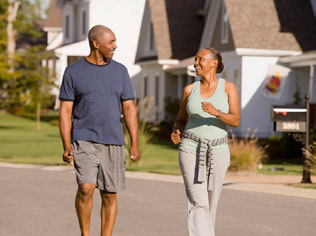National Center for Health Promotion and Disease Prevention
Be Physically Active
Being physically active can improve your health. Any amount of physical activity is better than none. A single bout of activity provides immediate health benefits such as lowering anxiety and blood pressure and improving quality of sleep. There are even more long-term health benefits.
What's Important to Know?
All adults should avoid inactivity by moving more throughout the day. Regular physical activity lowers the risk of depression, type 2 diabetes, heart disease, high blood pressure, obesity, stroke, and 8 types of cancer. It may also reduce the risk of weight gain, dementia, and falls, improve bone health, endurance and help you feel more energetic. Be active for any and all reasons that are meaningful to you!
Physical activity is anything that gets the body moving. It can be moderate intensity, meaning that you can talk while being active, or it can be vigorous intensity, meaning that you cannot say more than a few words without taking a breath. Choose activities that you enjoy and start at a comfortable level. Once the activity begins to seem easy, be active for a longer amount of time, or be active more often, or a combination of both.
Physical activity is safe for almost everyone, and its health benefits far outweigh the risks. Even if you think you are out of shape, or have not been active in a long time, you can still be active safely. Unless you have a chronic condition, such as diabetes, heart disease or arthritis, or you have active symptoms, such as chest pain or pressure, dizziness, or joint pain, you do not need to talk to your health care team before starting activity. If you have a concern about a health condition, talk with your health care team about the types and amounts of activity that are best for you.

For important health benefits, do at least 2½ hours of moderate-intensity or 1¼ hours of vigorous-intensity aerobic activity each week, or an equal combination of both. Any amount of activity is better than none and your episodes of activity can last any amount of time. You should be active as often as possible during the day and week.
Do muscle strengthening activities at least twice each week and try to use muscles from all parts of your body—the legs, hips, back, chest, abdomen, shoulders, and arms. Stretching regularly can improve flexibility, joint motion, circulation, and can also help relieve stress.
Want to Know More?
If you want to learn more about how to be physically active, talk with your VA health care team. They can also help if you have questions about making a healthy living change. If you would like more information about ways to be physically active and to improve your health, visit the websites below for the second edition of the Physical Activity Guidelines for Americans or the National Institute on Aging.
Resources
- Centers for Disease Prevention (CDC): Physical Activity
- Move Your Way: Tips for Getting Motivated
- Move Your Way: Tips for Busy Days
- National Institutes of Health (NIH) - National Institute on Aging
- Office of Disease Prevention and Health Promotion (ODPHP)
- President’s Council on Fitness, Sports & Nutrition
- Veterans Health Library




















